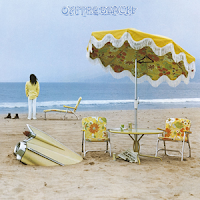May 1974: An ambulance can only go so fast
There are few albums that engendered quite as much buyer’s remorse as Neil Young’s “Time Fades Away,” the 1973 follow-up to his fabulously successful “Harvest,” which included what is still his biggest (and only) hit record, “Heart of Gold” and set up the public perception of Young as the laidback singer/songwriter recording songs of yearning from the back of his barn. “Time Fades Away” was anything but.
The genesis of “Time Fades Away” begins with Young and his band rehearsing for the tour in support of “Harvest.” As it became increasingly obvious that guitarist Danny Whitten was in no shape to go on a major arena tour, thanks to a heroin addiction, Young bought him a plane ticket and sent him home – where he promptly overdosed and died.
"Any big event will inspire a song, and that indeed was a very large event,” Young said later. “I think that's the first major life-and-death event that really affected me in what I was trying to do. Like when one of your parents dies or a friend dies, you kinda reassess yourself as to what you're doing – because you realize life is so impermanent. So you wanna do the best you can while you're here."
The tour, with Whitten’s death hanging over it, was by all accounts a miserable slog – 61 shows from January through April – but Young began using the concerts to introduce new songs he’d written on the road that felt more despairing than anything. The “Time Fades Away” album captured most of the new stuff, behind one of the ugliest album covers ever.Fast-forward to the wee hours of May 16, 1974, as Young plays an unannounced set at The Bottom Line in New York City following a Ry Cooder/Leon Redbone double bill. “I’m just passing through,” he tells the audience, as if he were an itinerant minstrel wandering the countryside. In truth, he’d just recorded an album scheduled for an August release titled “On the Beach,” and was eager to work out some of the new songs in front of an audience.
The new stuff had the same gloomy feel as much of “Time Fades Away,” and while Young rarely wrote songs “ripped from the headlines” as they say, he previewed songs alluding to Watergate, the oil embargo, the Manson Family and the Patty Hearst kidnapping. During The Bottom Line show, he introduces a new song, the rambling “Ambulance Blues” – even the title is a bring down – with “Here’s another bummer,” before disarming the comment with a pause, then “It’s my trip, man.”
Whether subconsciously or not, Young lifted the melody for “Ambulance Blues” from the British folk singer/guitarist Bert Jansch’s touching “Needle of Death,” a song whose title gives away everything, and which more or less fits with the unspoken theme of “On the Beach” and a preoccupation with Young around this time. It’s not a record about drugs, but there’s always a feeling of desolation and doom waiting right on the horizon. That a song on the album is titled “See the Sky About to Rain,” is probably not coincidental.
At times, “On the Beach” has all the lethargic energy of a junkie nodding out. On “Vampire Blues,” a song apparently about the oil embargo, there’s a guitar solo that barely gets going before it just starts to circle the drain and vanish. Heck, Young could barely come up with song titles for the album, preferring to just attach “blues” to several song names.
As Young told The Bottom Line audience, he and his pals had lately been under the influence of cheap street weed cooked down in a frying pan, mixed with honey and eaten. “Worse than heroin,” someone in Young’s entourage later called it – “worse” in that there was an endless supply, it cut productivity to a trickle and all without any of those bothersome needles.
Following “Time Fades Away” and “On the Beach,” Young completed his trilogy of doom in 1975 with the album “Tonight’s the Night,” a drunken wake for Danny Whitten and Young’s equipment tech Bruce Berry, another OD victim. Later that year he released the album “Zuma,” which wasn’t quite a walk along the beach either, but one could start to see cracks of sunlight through the clouds.
Nothing gloomy or despairing about the top ten records for May 1974; the only sinister thing here is Mike Oldfield’s “Tubular Bells” from The Exorcist. Rare for the times, there are three instrumentals this month: “Tubular Bells,” “TSOP” and “The Entertainer,” from another soundtrack (The Sting). Written in 1903 by Scott Joplin, it sparked a revival of Joplin’s piano rags; by September 1974, albums of Joplin’s music would occupy the #3, 4 and 5 spots on Billboard’s Best Selling Classical LPs list, staying on the charts for 64 weeks. Record World magazine called it the "classical phenomenon of the decade.”
1 THE STREAK –•– Ray Stevens
2 DANCING MACHINE –•– The Jackson 5
3 THE LOCO-MOTION –•– Grand Funk
4 THE ENTERTAINER –•– Marvin Hamlisch
5 THE SHOW MUST GO ON –•– Three Dog Night
6 BENNIE AND THE JETS –•– Elton John
7 TSOP (The Sound Of Philadelphia) –•– MFSB Featuring the Three Degrees
8 BAND ON THE RUN –•– Paul McCartney and Wings
9 MIDNIGHT AT THE OASIS –•– Maria Muldaur
10 TUBULAR BELLS –•– Mike Oldfield


No comments:
Post a Comment